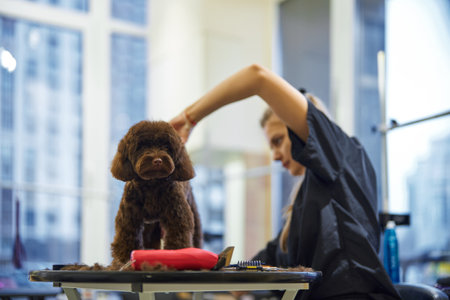1. Active Listening Skills
A good veterinarian listens attentively to your concerns, asks follow-up questions, and ensures that you feel heard and understood. When visiting a vet, their ability to actively listen plays a crucial role in providing the best care for your pet.
Signs of Active Listening in a Veterinarian
Not all veterinarians have the same communication style, but a great vet will display clear signs of active listening. Here are some key indicators:
| Signs of Active Listening | What It Means |
|---|---|
| Makes eye contact | The vet is engaged and paying attention to you. |
| Nods and responds appropriately | The vet acknowledges your concerns and encourages open communication. |
| Asks relevant follow-up questions | The vet seeks to understand the full picture before making recommendations. |
| Restates or summarizes your concerns | The vet ensures they fully understand your issue before giving advice. |
| Avoids interrupting while you speak | The vet gives you space to explain without rushing the conversation. |
Why Active Listening Matters
A veterinarian who actively listens can make more accurate diagnoses, provide better treatment options, and build trust with pet owners. If your vet seems distracted or dismissive, it may be worth considering another professional who prioritizes effective communication.
2. Clear and Compassionate Explanations
A great veterinarian ensures that pet owners fully understand their pet’s health by providing clear and compassionate explanations. They avoid overly technical jargon and break down medical conditions, treatment options, and procedures in a way that is easy to grasp. This helps pet parents make informed decisions about their pet’s care with confidence.
Breaking Down Medical Information
Veterinarians who communicate well take the time to explain complex medical terms in simple language. Instead of using scientific terminology that might be confusing, they relate the information in a way that makes sense to the average pet owner. For example:
| Technical Term | Simple Explanation |
|---|---|
| Dermatitis | Skin inflammation that can cause itching, redness, or discomfort. |
| Anemia | A condition where your pet has fewer red blood cells, making them feel weak or tired. |
| Gastroenteritis | An upset stomach that can cause vomiting or diarrhea. |
Providing Treatment Options Clearly
A good veterinarian presents different treatment options along with their benefits, risks, and costs. They ensure pet owners understand what each option entails so they can choose what’s best for their pet and personal circumstances. A knowledgeable vet will also discuss alternative treatments when available, rather than pushing only one solution.
Encouraging Questions and Concerns
An excellent vet creates an open and welcoming environment for questions. They never make a pet owner feel rushed or hesitant about asking for clarification. Instead, they patiently listen and provide thoughtful responses to concerns. If they don’t have an immediate answer, they are honest about researching further before giving advice.
The Role of Compassion in Communication
A veterinarians ability to explain things clearly is important, but so is the way they do it. A great vet delivers information with empathy and kindness, understanding that medical issues can be stressful for pet owners. They reassure worried pet parents while providing realistic expectations about their pet’s condition.
Signs of Clear and Compassionate Communication
- The vet explains medical terms in simple words.
- Treatment options are presented with pros and cons.
- The vet encourages questions without making owners feel rushed.
- Their tone is warm, patient, and understanding.
- The vet checks if the owner fully understands before moving on.
A veterinarian who communicates clearly and compassionately helps build trust between themselves and pet owners. When you leave an appointment feeling informed and supported, you know you’ve found a great vet!

3. Open to Questions and Discussions
A good veterinarian understands that pet owners want the best for their furry companions. They should be approachable, patient, and open to answering any questions you may have about your pets health and treatment options.
Encourages Questions
A trustworthy vet welcomes your questions rather than rushing through an appointment. They should take the time to explain medical terms in simple language and ensure you fully understand your pet’s condition.
Provides Thoughtful Responses
When a vet responds thoughtfully, it shows they genuinely care about your concerns. Instead of giving vague answers, they should provide clear explanations and discuss potential risks and benefits of treatments.
Discusses Alternative Treatment Options
Not every treatment plan is one-size-fits-all. A great vet will consider alternative options based on your pet’s needs, lifestyle, and medical history. They should involve you in the decision-making process and respect your input.
Signs of a Vet Who Encourages Questions vs. One Who Doesnt
| Encouraging Vet | Unapproachable Vet |
|---|---|
| Listens patiently and answers all questions | Rushes through explanations or dismisses concerns |
| Explains medical terms in easy-to-understand language | Uses complex jargon without clarification |
| Presents different treatment options with pros and cons | Only suggests one option without discussion |
| Makes time for follow-up questions | Avoids further discussion or seems impatient |
The Importance of Open Communication
Having a vet who encourages discussions builds trust and helps you make informed decisions about your pet’s health. If you ever feel rushed or unheard, it may be worth considering another veterinary practice where open communication is valued.
4. Body Language and Tone
A veterinarian’s body language and tone of voice can tell you a lot about their approach to patient care. A good veterinarian maintains eye contact, uses a calm and reassuring tone, and exhibits empathy toward both you and your pet. These non-verbal cues help build trust and make the experience less stressful for everyone involved.
Eye Contact and Engagement
A trustworthy veterinarian will maintain appropriate eye contact when speaking with you. This shows that they are actively listening and genuinely care about your concerns. If a vet avoids eye contact or seems distracted, it may indicate a lack of engagement or interest in your pet’s well-being.
Calm and Reassuring Tone
The way a veterinarian speaks is just as important as what they say. A soothing and steady tone can help reassure both you and your pet, making the visit more comfortable. If a vet speaks too quickly, harshly, or impatiently, it could add unnecessary stress to the situation.
Empathy Toward You and Your Pet
A compassionate vet will show empathy not just through words but also through their actions. They may gently handle your pet, acknowledge your concerns, and offer comfort during difficult moments. Here’s a quick comparison of positive versus negative body language:
| Positive Body Language | Negative Body Language |
|---|---|
| Maintains eye contact | Avoids eye contact |
| Speaks in a calm, steady voice | Uses a rushed or harsh tone |
| Kneels or gets on your pet’s level | Stands stiffly or appears distant |
| Gently handles your pet | Mishandles or ignores your pet |
| Nods and acknowledges concerns | Interrupts or dismisses concerns |
The Importance of Non-Verbal Communication
Your pet can’t express themselves in words, so they rely on body language to communicate comfort or distress. A skilled veterinarian understands this and adjusts their approach accordingly. By observing how a vet interacts with animals—whether they take their time to let pets warm up to them or rush into an exam—you can gauge their level of patience and care.
5. Follow-Up and Availability
One of the key traits of a great veterinarian is their commitment to follow-up care and availability. A vet who genuinely cares about your pet won’t just treat them and send them home without further communication. Instead, they make sure you have all the necessary information for post-treatment care and remain accessible for any questions or concerns.
They Check In After Major Treatments
A good veterinarian doesn’t just perform procedures and move on. They follow up after major treatments, surgeries, or serious illnesses to see how your pet is recovering. This could be through a phone call, an email, or even a scheduled follow-up visit. Their willingness to check in shows their dedication to your pet’s well-being.
Clear Instructions for Follow-Up Care
After any treatment, clear instructions are essential for proper recovery. A quality vet provides detailed guidance on medication schedules, dietary changes, activity restrictions, and signs of complications to watch for. Here’s what a good vet’s follow-up instructions might include:
| Follow-Up Aspect | What to Expect |
|---|---|
| Medication Instructions | Clear dosage guidelines and potential side effects |
| Dietary Advice | Specific food recommendations or restrictions |
| Activity Guidelines | Limits on exercise and movement during recovery |
| Warning Signs | Symptoms that require immediate attention |
| Next Steps | Scheduling follow-up visits if needed |
Accessible for Questions and Emergencies
A responsible veterinarian understands that pet owners may have concerns after leaving the clinic. They ensure that you can reach out with questions via phone or email and provide emergency contact information when necessary. Whether it’s a reaction to medication or unusual behavior after a procedure, knowing your vet is available offers peace of mind.
How Can You Tell If a Vet Is Available?
- They encourage you to call if any issues arise.
- Their clinic has reasonable hours with emergency options.
- Their staff responds promptly to inquiries.
- They offer telehealth consultations when appropriate.
- You don’t feel like you’re left alone after treatment.
A veterinarian’s communication style plays a huge role in ensuring your pet receives the best possible care. By choosing one who follows up regularly and remains available for concerns, you can feel more confident in your pets health journey.


